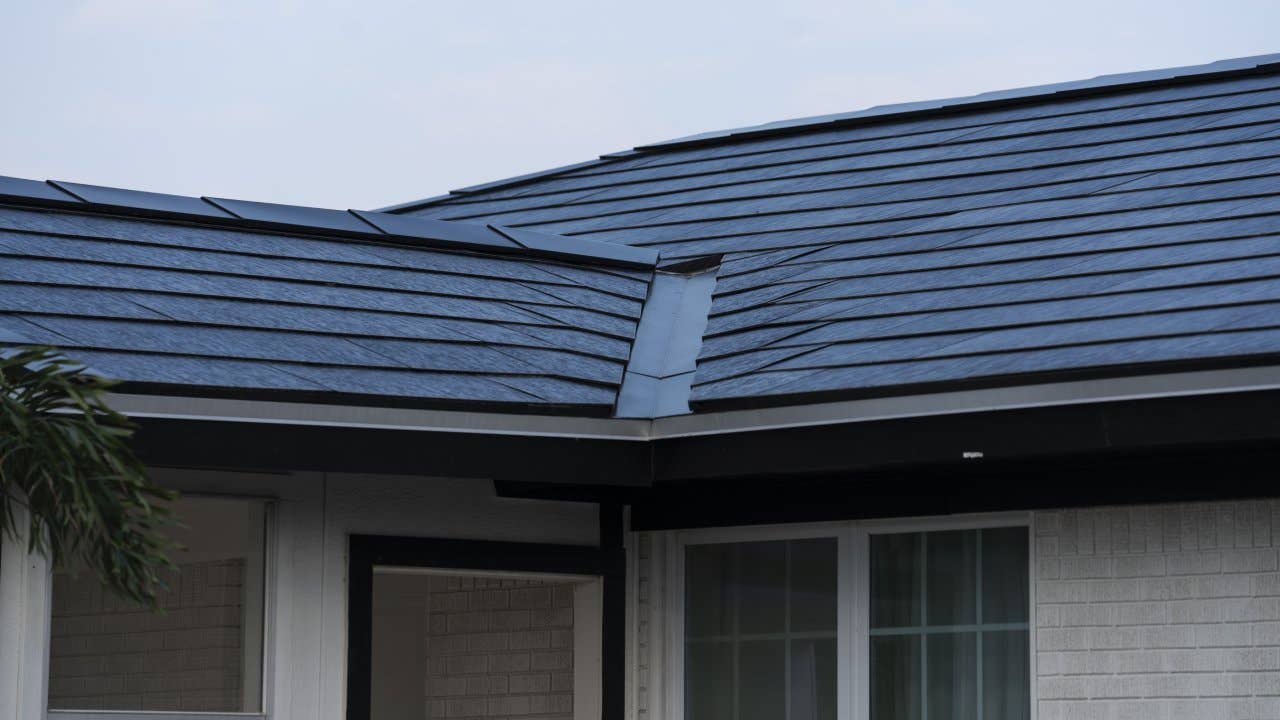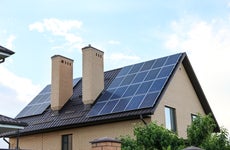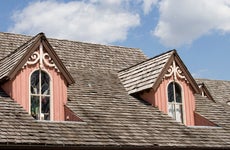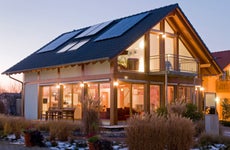Should you replace your roof with solar shingles?

The Bankrate promise
At Bankrate we strive to help you make smarter financial decisions. While we adhere to strict , this post may contain references to products from our partners. Here's an explanation for .
By 2030, more than 100 million households will rely on rooftop solar power, according to estimates from the International Energy Agency. If you’re one of the homeowners interested in shrinking your carbon footprint and your energy costs, you are no longer limited to solar panels to help power your home, though.
Can solar panels save you money?
Now there’s another option: an entire solar roof.
Solar roofs are composed of solar shingles that can fit over existing shingles or be installed on their own. So the energy-harvesting ability is baked into the roof itself. The shingles do everything regular shingles do, roof-wise (protect your house from the elements), and are quite durable. Plus, they appear a lot more sleek and seamless than solar panels. “It’s such a different look,” says Cassie Morien, director of strategy at Modernize Home Services, a home improvement and contractor platform. Shingles simply “look sexier on your roof.”
But looks don’t come cheap. Should you replace your roof with solar shingles — or, start out with a solar roof if you’re doing a new build? Here’s everything you need to know.
What are solar shingles?
If you’ve never heard of solar shingles, you’re not alone. According to an October 2023 study of more than 1,100 homeowners across the U.S. conducted by Modernize, 38 percent of people are not familiar with them, even though they’re over a decade old.
“Also known as solar roofs, solar tiles, or solar roof tiles, solar shingles are tile-shaped panels permanently installed on your home’s roof,” Mallory Micetich, home expert at home improvement site Angi, says. “The panels are much smaller than conventional solar panels, but they operate in a similar way, with building-integrated photovoltaic systems, an inverter and a circuit that allows the solar energy to be absorbed and flow through the wires into your home.”
Each shingle produces anywhere from 13 to 80 watts of energy, depending on the brand. The average size of a solar shingle or tile is about 12 inches wide by 86 inches long. It takes about 350 solar tiles for a standard-size roof. Tiles weigh about 13 pounds per square foot, so most roofs can handle them without additional reinforcement.
The first solar shingles were developed by DOW Chemical Company, rolling out in 2011. But the concept began to get serious traction in 2016, when Tesla purchased manufacturer Solar City and began offering what it deemed the Tesla Solar Roof. Today, there are several brands of the solar roof tiles available from manufacturers CertainTeed, GAF Energy, Luma, SunTegra and of course Tesla. (Dow dropped out of the game.)
The pros and cons of solar shingles
As you weigh your options for what’s over your head, it’s important to think about the upsides and downsides of solar shingles.
Pros of solar shingles
- Style: With the ability to blend in with your roof, solar shingles are easier on the eyes.
- Savings: Using solar energy reduces your energy bills and your impact on the environment.
- Strength: Solar shingles are designed to be highly weather-resistant and durable, and manufacturers also include warranties that will cover them up to certain wind speeds — an extra layer of comfort when investing in the job. Additionally, there are warranties that guarantee a certain level of energy output.”
Cons of solar shingles
- High costs: Solar shingles are going to require a large upfront investment, and they are much more expensive than a standard roof or solar panels. In some cases, if you want a complete redo, you’ll have to pay for removing your old roof, too.
- Fewer choices: Depending on where you live, you may struggle to find certified roofers who have experience with this newer technology.
- Less versatile/efficient: Since they’re part of the roof itself, solar shingles cannot be installed at angles or in locations to capture maximum sunlight
What do solar shingles cost?
According to Angi, solar shingles cost between $21 and $25 per square foot ( $2,100 to $2,600 per roofing square), adding up to a total average cost of $55,000. That’s certainly much higher than the typical solar panel job, which has an average price tag of $16,500, according to estimates from Modernize.
When it comes to shingles, there are a range of factors that impact the overall cost, but if your roof has some steep angling – anything that exceeds a standard 6:12 ratio – expect to pay more. Additionally, your location plays a key role. Angi’s data shows that average installation costs in California are $70,000 per job, while homeowners in Florida and Michigan pay half that sum.
Regardless of where you live, expect to budget for a significant premium compared with a standard roof, which typically ranges from $5,600 to $12,000. While that’s quite the jump in price tag, installing solar shingles – or solar panels – now comes with the ability to reduce your federal tax bill. The Inflation Reduction Act allows a dollar-for-dollar federal tax credit on up to 30 percent of solar installation costs through 2032.
Also: Solar shingle prices have dropped since their introduction, and they may continue to do so, especially if more manufacturers and installers enter the market.
What to consider when choosing solar shingles for your home
As you compare different options for your roof, be sure to think about these key considerations that can help you select the right solar shingles to lower your carbon footprint without breaking the bank.
Materials
Some of these shingles are made with copper indium gallium selenide, and others are made with monocrystalline silicon. According to installation company Texas Solar Group, monocrystalline silicon is more expensive, but it’s also more efficient at energy conversion.
Energy output
As you compare different options for solar, you’ll need to think about how much energy you actually use on a regular basis. According to the U.S. Energy Information Administration, the average home uses around 886 kilowatt hours of electricity per month. While solar shingles vary in their overall wattage output, and costs increase correspondingly with that output, Micetich points out that “you don’t need to replace your entire roof with solar shingles. You can just do one area of your roof and still get plenty of benefit.”
Solar shingles can be placed on most types of homes – even if it isn’t directly under a beaming sun. “It’s important to note that your roof doesn’t need to be in full sunlight for the shingles to be effective,” Micetich says. “They make use of diffuse, scattered light, so they work even on overcast and rainy days.”
Installation
Even if you’re confident that solar shingles are the right choice for your roof, you may need to search for someone confident enough to do the job.
“Solar roof shingles are a newer technology compared to traditional solar panels and therefore are less likely to have a line of professional installation contractors to install them on your home,” Micetich says. “This means you might have to search longer and harder to find a solar roof shingle installer near you. Generally, we see that southern states that receive a lot of direct sunlight have a larger market for all solar products. These states include California, Nevada, Arizona, Texas and Florida.”
Your plans for excess energy
In addition to making sure your singles can produce enough energy, you’ll need to think about the opposite end: What can you do when you have more than you need?
“There are two options when considering excess energy from your solar shingles,” Micetich says. “One option is that you can opt to pass it to the local electric grid and then get paid for it. While all counties have different methods of compensating homeowners who produce excess solar energy, it’s usually in the form of a check or a deduction on their next bill.”
You can also opt to install a solar battery to store excess energy, which your system can use at night, on cloudy days and during power outages. “A single emergency-use battery can cost about $200, while a long-lasting, high-efficiency lithium-ion system can add up to $14,000 to your upfront cost,” according to Micetich.
Aesthetics
The fact that solar shingles can simulate traditional ones, adapting to almost any roof style, is a key difference that sets them apart from solar panels. While aesthetics may not be your primary concern, it could help if you have an HOA that sets a great store by neighborhood appearances, and has a history of objecting to the addition of solar panels on roofs.
Cost
Roofs in general are expensive propositions, and a solar roof is on the high side. Even expensive traditional roof materials like clay or slate cost less than solar tile. With an average cost of $55,000, you will need to think about how long you plan to be in the home to make sure that you have enough time to let all your energy savings add up and justify that investment. For a lot of homeowners, that kind of price tag might be enough to scare you away from the investment: Respondents in Modernize Home Services’ survey listed cost-effectiveness as their number-one priority with aesthetics much further down the list.
However, if you absolutely love the look of solar shingles, you may want to look into financing options to avoid draining your savings. If you have a sizable chunk of equity, a home equity loan or a HELOC can be a good pick – plus, you’ll be increasing the value of the home, which can put you in the running for some tax benefits.
There are other options, too: “solar loans,” financing offered by installers or third parties. For example, Tesla offers a financing arrangement for its Solar Roof. LightStream offers solar loans up to $100,000, at APRs that currently range from 7.99 percent to 21.24 percent.
Durability and overall service life
Think about the potential for severe weather in your area. If high winds are a regular occurrence, you’ll want to compare how each product fares when it comes to wind or snow build-up. Make sure you compare product warranties, too. You’ll see a mix of manufacturer warranties (which protect against defects), wind warranties (which protect, naturally, against wind damage) and power warranties that typically guarantee a certain level of maximum performance depreciation per year. It’s also important to consider the potential for technology advancements. Luma, a well-known solar shingle manufacturer, offers the ability to upgrade the technology – an important consideration versus replacing the shingles down the line.
What do you save in energy costs with solar shingles?
While expensive to install, a solar roof can save in the long run. Depending on the number of tiles on your roof, solar shingles can reduce energy costs by anywhere from 40 to 60 percent, according to the consumer education site SolarReviews. Additionally, you may be eligible for federal and state tax incentives.
The Inflation Reduction Act makes a difference in your upfront costs with that 30 percent tax credit on the installation cost. Plus, several states offer credits, rebates and other incentives as well. There is a maze of information about those potential savings, but this database from North Carolina State University can sift through programs that apply to certain zip codes around the country.
Solar shingles vs. solar panels: Which is better?
Both solar shingles and solar panels can be a great option to take your home energy efficiency to the next level. But which is best for you? Solar panels tend to win when it comes to cost, while solar shingles tend to come out on top when it comes to their overall look.
One key benefit of solar panels is that the technology has been around longer, meaning there are more easily accessible tools to do your research. Solar shingles simply aren’t as widely popular, which means your research options are more limited.
As you start that research, here’s a rundown of some of the key points of differentiation as you try to decide what’s best to put above your head:
Solar shingles
- Must be installed on your roof
- More aesthetically pleasing – simulate standard shingles
- Newer technology – fewer companies to choose from
- More expensive
Solar panels
- Can also be installed on the ground or in another location to absorb direct sunlight
- Panels stick out, look obviously like panels
- More established technology – more choices
- More affordable – average cost is around $30,000 lower than solar shingles
The final word on solar shingles
Solar shingles are still fairly new, which means their exact lifespan and durability is still something of a question mark. Still, if you’re an environmentally-conscious homeowner in need of a full roof replacement or a roof for a new build, solar shingles are worth considering — especially with some states now requiring that newly built homes be solar power-equipped.
To sum up: “Solar panels are more affordable and portable,” Micetich says, “while solar shingles are more attractive and may have a longer lifespan.”
Either way, with enhanced federal tax credits in effect, the time to get up on the solar roof may be now.
FAQ
-
Tesla is the most recognizable name in solar shingles. However, the same name that you see on carbon-free cars on the highway isn’t the only name in solar shingle manufacturing. Luma, SunTegra, CertainTeed and GAF Energy’s Timberline Solar are some of the top solar shingle brands to consider.
-
Yes, solar shingles usually come with a warranty that covers a range of potential problems such as manufacturing defects and wind damage, and many of these last up to 25 years. These also typically guarantee a certain level of energy production per year. However, as with any warranty, it’s important to read the fine print to determine what’s covered.
-
Since they’re relatively new, there’s little data on how much solar shingles (or panels for that matter) specifically will impact your home’s worth. However, making your home more energy efficient – which solar shingles can do – can have a positive impact on your property value. Research from the Department of Energy and the National Association of Realtors has shown that buyers are looking for homes with sustainable features. However, this is not a job to invest in with the sole hope of increasing your sales prices. Installing solar shingles only makes sense if you’re planning to be in the home long enough to make the energy savings justify the upfront costs.
Related Articles



